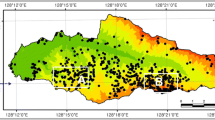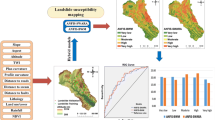Abstract
In this paper, an adaptive neuro-fuzzy modeling (ANFIS) is applied in order to map landslide susceptibility for a Mediterranean catchment (Peloponnese, Greece). The relationship between landslides and factors influencing their occurrence is investigated in GIS environment. Seven conditioning factors, including elevation, slope angle, profile curvature, stream density, distance to main roads, geology, and vegetation were considered in the analysis. Six ANFIS models with different membership functions were developed to generate the corresponding landslide susceptibility maps. The outputs, representing the probability level of landslide occurrence, were grouped into five classes. They were then evaluated using an independent dataset of landslide events in two different validation methods: receiver operating characteristics (ROC) analysis and success and prediction rates. The majority of the calculated area under the curve values for the two validation methods was in the range 0.70–0.90 indicating between fair and very good prediction accuracy for the six models. These values also showed that the prediction accuracy depends on the membership functions examined in the ANFIS modeling. Among these functions, the difference of two sigmoidally shaped (Dsigmf) and product of two sigmoidally shaped (Psigmf) presented the highest prediction accuracy.







Similar content being viewed by others
References
Akgun A (2012) A comparison of landslide susceptibility maps produced by logistic regression, multi-criteria decision, and likelihood ratio methods: a case study at Izmir, Turkey. Landslides 9(1):93–106
Allahverdi N, Tunali A, Işik H, Kahramanli H (2011) A Takagi-Sugeno type neuro-fuzzy network for determining child anemia. Expert Syst Appl 38(6):7415–7418
Atsalakis GS, Valavanis KP (2009) Forecasting stock market short-term trends using a neuro-fuzzy based methodology. Expert Syst Appl 36(7):10696–10707
Avtar R, Singh CK, Singh G, Verma RL, Mukherjee S, Sawada H (2011) Landslide susceptibility zonation study using remote sensing and GIS technology in the Ken-Betwa River Link area, India. Bull Eng Geol Env 70:595–606
Brabb EE (1984) Innovative approaches to landslide hazard mapping. In: Proceedings of the 4th international symposium on landslides, pp 307–324
Cervi F, Berti M, Borgatti L, Ronchetti F, Manenti F, Corsini A (2010) Comparing predictive capability of statistical and deterministic methods for landslide susceptibility mapping: a case study in the northern Apennines (Reggio Emilia Province, Italy). Landslides 7(4):433–444
Chalkias C, Ferentinou M, Polykretis C (2014a) GIS-based landslide susceptibility mapping on the Peloponnese Peninsula, Greece. Geosciences 4:176–190
Chalkias C, Ferentinou M, Polykretis C (2014b) GIS supported landslide susceptibility modeling at regional scale: an expert-based fuzzy weighting method. ISPRS Int J Geo Inf 3:523–539
Chalkias C, Kalogirou S, Ferentinou M (2014c) Landslide susceptibility, Peloponnese Peninsula in South Greece. J Maps 10(2):211–222
Chen CH, Ke CC, Wang CL (2009) A back-propagation network for the assessment of susceptibility to rock slope failure in the eastern portion of the Southern Cross-Island Highway in Taiwan. Environ Geol 57:723–733
Chiu SL (1997) An efficient method for extracting fuzzy classification rules from high dimensional data. Adv Comput Intell 1:1–7
Choi J, Oh HJ, Lee HJ, Lee C, Lee S (2012) Combining landslide susceptibility maps obtained from frequency ratio, logistic regression, and artificial neural network models using ASTER images and GIS. Eng Geol 124:12–23
Cruden DM, Varnes DJ (1996) Landslide types and processes. In: Turner AK, Schuster RL (eds) Landslides: investigation and mitigation, special report. National Academy Press, Washington, pp 36–75
Dagdelenler G, Nefeslioglu HA, Gokceoglu C (2016) Modification of seed cell sampling strategy for landslide susceptibility mapping: an application from the Eastern part of the Gallipoli Peninsula (Canakkale, Turkey). Bull Eng Geol Env 75(2):575–590
Dai FC, Lee CF (2002) Landslide characteristics and slope instability modeling using GIS, Lantau Island, Hong Kong. Geomorphology 42:213–228
Ferentinou M, Chalkias C (2013) Mapping mass movement susceptibility across Greece with GIS, ANN and statistical methods. Landslide Science and Practice, pp 321–327
Garson GD (1991) Interpreting neural network connection weights. AI expert 6:47–51
Hasanipanah M, Amnieh HB, Arab H, Zamzam MS (2016) Feasibility of PSO–ANFIS model to estimate rock fragmentation produced by mine blasting. Neural Comput Appl 1–10. doi:10.1007/s00521-016-2746-1
Hellenic Military Geographical Service – HMGS (1989) General Use Map of Greece, 1:50,000, Evinohorion, Nafpaktos, Amygdalea, Patrae, Halandritsa, Aiyion, Dhervenion, Xylokastro, Perahora, Kertezi, Dhafni, Kandhila, Nemea, Korinthos, Sofikon, Tripolis, Nafplion, and Lygourion sheets
Institute of Geology and Mineral Exploration – IGME (1993) Geological Map of Greece, 1:50,000, Evinohorion, Nafpaktos, Amygdalea, Patrae, Halandritsa, Aiyion, Dhervenion, Xylokastro, Perahora, Kertezi, Dhafni, Kandhila, Nemea, Korinthos, Sofikon, Tripolis, Nafplion, and Lygourion sheets
Ilia I, Tsangaratos P (2016) Applying weight of evidence method and sensitivity analysis to produce a landslide susceptibility map. Landslides 13(2):379–397
Intarawichian N, Dasananda S (2011) Frequency ratio model based landslide susceptibility mapping in lower Mae Chaem watershed, Northern Thailand. Environ Earth Sci 64:2271–2285
Jang JSR (1993) ANFIS: adaptive-network-based fuzzy inference systems. IEEE Trans Syst Man Cybern 23:665–685
Kouli M, Loupasakis C, Soupios P, Rozos D, Vallianatos F (2014) Landslide susceptibility mapping by comparing the WLC and WofE multi-criteria methods in the West Crete Island, Greece. Environ Earth Sci 72(12):5197–5219
Laboratory of Engineering Geology, Department of Geology, University of Patras, (2016) Landslide Inventory Database. http://www.geoarch.gr/. Accessed 5 Sept 2016
Listo FDLR, Carvalho Vieira B (2012) Mapping of risk and susceptibility of shallow-landslide in the city of Sao Paulo, Brazil. Geomorphology 169–170:30–44
Meng Q, Miao F, Zhen J, Wang X, Wang A, Peng Y, Fan Q (2016) GIS-based landslide susceptibility mapping with logistic regression, analytical hierarchy process, and combined fuzzy and support vector machine methods: a case study from Wolong Giant Panda Natural Reserve, China. Bull Eng Geol Environ 75(3):923–944
Montrasio L, Valentino R, Losi GL (2011) Towards a real-time susceptibility assessment of rainfall-induced shallow landslides on a regional scale. Nat Hazards Earth Syst Sci 11:1927–1947
Nazari-Shirkouhi S, Keramati A, Rezaie K (2013) Improvement of customers’ satisfaction with new product design using an adaptive neuro-fuzzy inference systems approach. Neural Comput Appl 23(1):333–343
Oh HJ, Pradhan B (2011) Application of a neuro-fuzzy model to landslide-susceptibility mapping for shallow landslides in a tropical hilly area. Comput Geosci 37:1264–1276
OpenStreetMap (2016) https://www.openstreetmap.org/. Accessed 15 Sept 2016
Osna T, Sezer EA, Akgun A (2014) GeoFIS: an integrated tool for the assessment of landslide susceptibility. Comput Geosci 66:20–30
Palamakumbure D, Flentje P, Stirling D (2015) Consideration of optimal pixel resolution in deriving landslide susceptibility zoning within the Sydney Basin, New South Wales, Australia. Comput Geosci 82:13–22
Papathanassiou G, Valkaniotis S, Ganas A, Pavlides S (2013) GIS-based statistical analysis of the spatial distribution of earthquake-induced landslides in the island of Lefkada, Ionian Islands. Greece. Landslides 10(6):771–783
Peduzzi P (2010) Landslides and vegetation cover in the 2005 North Pakistan earthquake: a GIS and statistical quantitative approach. Nat Hazards Earth Syst Sci 10:623–640
Petković D, Ćojbašić Ž (2012) Adaptive neuro-fuzzy estimation of autonomic nervous system parameters effect on heart rate variability. Neural Comput Appl 21(8):2065–2070
Pnevmatikos JD, Katsoulis BD (2006) The changing rainfall regime in Greece and its impact on climatological means. Meteorol Appl 13:331–345
Polykretis C, Ferentinou M, Chalkias C (2015) A comparative study of landslide susceptibility mapping using landslide susceptibility index and artificial neural networks in the Krios River and Krathis River catchments (northern Peloponnesus, Greece). Bull Eng Geol Environ 74:27–45
Pradhan AMS, Kim YT (2014) Relative effect method of landslide susceptibility zonation in weathered granite soil: a case study in Deokjeok-ri Creek, South Korea. Nat Hazards 72:1189–1217
Pradhan AMS, Kim YT (2015) Application and comparison of shallow landslide susceptibility models in weathered granite soil under extreme rainfall events. Environ Earth Sci 73:5761–5771
Pradhan B, Lee S, Buchroithner MF (2010) A GIS-based back-propagation neural network model and its cross-application and validation for landslide susceptibility analyses. Comput Environ Urban Syst 34:216–235
Reis S, Yalcin A, Atasoy M, Nisanci R, Bayrak T, Erduran M, Sancar C, Ekercin S (2012) Remote sensing and GIS-based landslide susceptibility mapping using frequency ratio and analytical hierarchy methods in Rize province (NE Turkey). Environ Earth Sci 66:2063–2073
Remondo J, González-Díez A, Díaz de Terán JR, Cendrero A (2003) Landslide susceptibility models utilizing spatial data analysis techniques: a case study from the Lower Deba Valley, Guipúzcoa (Spain). Nat Hazards 30(3):267–279
Rezaeianzadeh M, Tabari H, Arabi Yazdi A, Isik S, Kalin L (2014) Flood flow forecasting using ANN, ANFIS and regression models. Neural Comput Appl 25(1):25–37
Romer C, Ferentinou M (2016) Shallow landslide susceptibility assessment in a semiarid environment—a quaternary catchment of KwaZulu-Natal, South Africa. Eng Geol 201:29–44
Sabatakakis N, Koukis G, Vassiliades E, Lainas S (2013) Landslide susceptibility zonation in Greece. Nat Hazards 65(1):523–543
Saito H, Nakayama D, Matsuyama H (2009) Comparison of landslide susceptibility based on a decision-tree model and actual landslide occurrence: the Akaishi Mountains, Japan. Geomorphology 109:108–121
Sakkas G, Misailidis I, Sakellariou N, Kouskouna V, Kaviris G (2016) Modeling landslide susceptibility in Greece: a weighted linear combination approach using analytic hierarchical process, validated with spatial and statistical analysis. Nat Hazards 84(3):1873–1904
Sdao F, Lioi DS, Pascale S, Caniani D, Mancini IM (2013) Landslide susceptibility assessment by using a neuro-fuzzy model: a case study in the Rupestrian heritage rich area of Matera. Nat Hazards Earth Syst Sci 13:395–407
Sezer EA, Pradhan B, Gokceoglu C (2011) Manifestation of an adaptive neuro-fuzzy model on landslide susceptibility mapping: Klang valley, Malaysia. Expert Syst Appl 38:8208–8219
Singh R, Vishal V, Singh TN, Ranjith PG (2013) A comparative study of generalized regression neural network approach and adaptive neuro-fuzzy inference systems for prediction of unconfined compressive strength of rocks. Neural Comput Appl 23(2):499–506
Special Secretariat for Water (2012) Management Plan for the River Catchments of Drainage District of Northern Peloponnese. Ministry of Environment, Energy and Climate Change, Athens, pp 1–456
Su C, Wang L, Wang X, Huang Z, Zhang X (2015) Mapping of rainfall-induced landslide susceptibility in Wencheng, China, using support vector machine. Nat Hazards 76:1759–1779
Takagi T, Sugeno M (1983) Derivation of fuzzy control rules from human operator’s control actions. In: Proceedings of the IFAC symposium on fuzzy information, knowledge representation and decision analysis, pp 55–60
Talei A, Chua LHC, Quek C (2010) A novel application of a neuro-fuzzy computational technique in event-based rainfall–runoff modeling. Expert Syst Appl 37(12):7456–7468
Tien Bui D, Pradhan B, Lofman O, Revhaug I, Dick OB (2012) Landslide susceptibility mapping at Hoa Binh province (Vietnam) using an adaptive neuro-fuzzy inference system and GIS. Comput Geosci 45:199–211
Tsagas D (2011) Geomorphological observations, and gravity movements in northern Peloponnesus. PhD dissertation, National and Kapodistrian University of Athens
Tsangaratos P, Benardos A (2014) Estimating landslide susceptibility through a artificial neural network classifier. Nat Hazards 74(3):1489–1516
Tsangaratos P, Ilia I (2016) Landslide susceptibility mapping using a modified decision tree classifier in the Xanthi Perfection, Greece. Landslides 13(2):305–320
Uçar T, Karahoca A, Karahoca D (2013) Tuberculosis disease diagnosis by using adaptive neuro fuzzy inference system and rough sets. Neural Comput Appl 23(2):471–483
Van Westen CJ, van Asch TWJ, Soeters R (2006) Landslide hazard and risk zonation: why is it still so difficult? Bull Eng Geol Environ 65:167–184
Acknowledgements
The authors are grateful to the anonymous reviewers for their useful comments and constructive manuscript revision.
Author information
Authors and Affiliations
Corresponding author
Rights and permissions
About this article
Cite this article
Polykretis, C., Chalkias, C. & Ferentinou, M. Adaptive neuro-fuzzy inference system (ANFIS) modeling for landslide susceptibility assessment in a Mediterranean hilly area. Bull Eng Geol Environ 78, 1173–1187 (2019). https://doi.org/10.1007/s10064-017-1125-1
Received:
Accepted:
Published:
Issue Date:
DOI: https://doi.org/10.1007/s10064-017-1125-1




